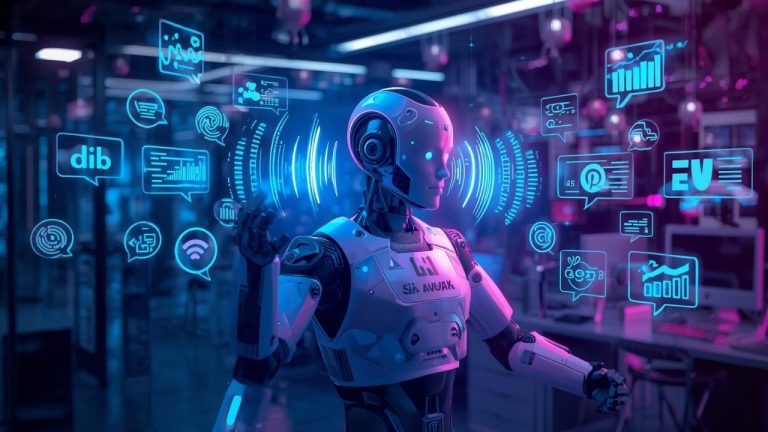
In the ever-evolving digital landscape, delivering a personalized user experience is no longer optional—it’s essential. Modern consumers expect websites to anticipate their needs, provide relevant content, and guide them seamlessly through the customer journey. Static, one-size-fits-all websites are quickly becoming outdated, as users increasingly demand interactions tailored to their preferences, behaviors, and context.
Artificial Intelligence (AI) has emerged as a game-changing technology for real-time website personalization. By leveraging data analytics, predictive modeling, and machine learning, AI enables websites to dynamically adjust content, recommendations, and interactions for each visitor. This not only enhances engagement but also improves conversions, customer satisfaction, and loyalty. This article explores how to personalize website experiences in real time with AI, the technologies involved, benefits, and best practices for implementation.
- Why Real-Time Personalization Matters
Real-time personalization refers to adjusting website content and functionality instantly based on user behavior, preferences, and context. Unlike traditional personalization, which may rely on static segments or historical data, real-time personalization reacts as users interact with a website.
The importance of real-time personalization includes:
- Higher Engagement: Tailored content keeps users interested and encourages exploration.
- Increased Conversions: Personalized product recommendations, CTAs, and messaging improve the likelihood of completing desired actions.
- Reduced Bounce Rates: Relevant, context-aware experiences make visitors more likely to stay on the site.
- Improved Customer Satisfaction: Users feel understood and valued, fostering trust and loyalty.
For example, a returning e-commerce visitor might be shown recently viewed products or personalized promotions, while a first-time visitor sees curated content based on location, device, or referral source.
- How AI Enables Real-Time Personalization
AI provides the intelligence and automation required to deliver dynamic, context-aware website experiences. Key AI capabilities that support real-time personalization include:
- Machine Learning (ML)
ML algorithms analyze visitor behavior, past interactions, and engagement patterns to predict user preferences. For example, an AI model may recognize that a visitor frequently purchases athletic apparel and prioritize showing related products.
- Predictive Analytics
AI can forecast what content, offers, or actions are likely to resonate with a visitor. Predictive models anticipate needs, enabling proactive recommendations or personalized messaging.
- Natural Language Processing (NLP)
NLP allows AI to understand user intent through text input, search queries, or chat interactions. Websites can use NLP to deliver contextually relevant information instantly.
- Behavioral Analytics
By tracking click patterns, scroll behavior, dwell time, and navigation paths, AI identifies which elements are most engaging and adapts experiences accordingly.
- Real-Time Decision Engines
AI-powered decision engines dynamically determine which content, products, or layouts to display based on visitor attributes, behavior, and predicted intent. This ensures personalized experiences are delivered immediately.
- Strategies for Real-Time Personalization
AI enables a variety of personalization strategies to engage users more effectively:
- Dynamic Content Recommendations
AI can present content that matches a visitor’s interests, preferences, or browsing history. Examples include:
- Blog posts related to previously read articles
- Product recommendations based on browsing behavior
- Suggested videos or resources tailored to user segments
By displaying the most relevant content, visitors are encouraged to explore further, increasing session duration and engagement.
- Personalized CTAs and Offers
Call-to-actions (CTAs) can be customized based on user intent, behavior, or stage in the customer journey. Examples include:
- Offering a discount to first-time visitors
- Prompting returning users to complete abandoned actions
- Highlighting high-value products for frequent shoppers
Dynamic CTAs increase the likelihood of conversion by presenting the right message at the right time.
- Adaptive Website Layouts
AI can adjust website layout, menus, and interactive elements in real time to match visitor preferences and device types. For instance, users accessing a site from a mobile device may see simplified navigation, larger buttons, and mobile-optimized content.
- Chatbots and Conversational AI
AI-driven chatbots can personalize interactions based on user behavior, history, and intent. They provide instant assistance, recommend products or content, and guide users through complex processes, reducing friction and enhancing the overall experience.
- Geolocation and Contextual Personalization
AI can leverage geolocation, language, and device context to deliver localized content, promotions, or product availability. For example, a visitor from a specific city might see a regional promotion or store information.
- Email and Push Integration
Real-time personalization doesn’t stop at the website. AI can synchronize recommendations and content across email, push notifications, and in-app messaging, ensuring a cohesive and personalized omnichannel experience.
- Benefits of AI-Powered Real-Time Personalization
Implementing AI-driven personalization offers numerous advantages for both users and businesses:
- Enhanced User Engagement
Visitors are more likely to interact with content and features that are relevant to them, increasing page views, session duration, and interaction depth.
- Higher Conversion Rates
By presenting the most relevant products, offers, and CTAs, AI boosts conversion potential and encourages repeat purchases or actions.
- Reduced Bounce Rates
Tailored experiences address visitor intent and reduce frustration, keeping users on the website longer.
- Improved Customer Loyalty
Personalization creates a sense of value and recognition, strengthening relationships and encouraging return visits.
- Actionable Insights
AI collects data on user interactions and behavior, providing insights for continuous improvement of content, UX, and marketing strategies.
- Operational Efficiency
AI automates personalization, reducing the need for manual segmentation, content updates, and guesswork in targeting visitors.
- Implementing Real-Time Personalization with AI
Here’s a step-by-step approach to building AI-powered, personalized website experiences:
Step 1: Define Personalization Goals
Decide what outcomes you want from personalization, such as increasing engagement, reducing bounce rates, or improving conversions.
Step 2: Collect and Organize Data
Gather visitor data from multiple sources, including browsing behavior, purchase history, demographic information, referral sources, and previous interactions. Ensure data privacy and compliance with regulations like GDPR.
Step 3: Choose AI Tools
Select AI solutions that offer machine learning, predictive analytics, behavioral tracking, and integration with your website CMS, CRM, and marketing platforms.
Step 4: Segment and Profile Visitors
Use AI to automatically segment users based on behavior, intent, demographics, and preferences. This allows for targeted and relevant personalization.
Step 5: Implement Real-Time Content Personalization
Leverage AI decision engines to dynamically adjust content, layout, and CTAs based on visitor behavior and predicted intent. Test recommendations, offers, and messages continuously.
Step 6: Integrate Conversational AI
Deploy AI chatbots or virtual assistants to guide visitors, answer questions, and recommend relevant content or products. Ensure seamless escalation to human agents for complex queries.
Step 7: Monitor Performance and Iterate
Track key metrics such as engagement, session duration, conversion rates, and bounce rates. Use AI insights to continuously refine personalization strategies and improve UX.
- Best Practices for AI-Driven Personalization
To maximize the effectiveness of real-time personalization, consider these best practices:
- Start Small and Scale Gradually
Begin with high-priority pages or user segments to validate AI strategies before expanding site-wide.
- Focus on High-Impact Elements
Prioritize personalization for elements that significantly influence engagement and conversions, such as CTAs, product recommendations, and content sections.
- Maintain Transparency
Inform users about personalization and data usage. Transparency builds trust and encourages continued engagement.
- Balance Automation with Human Oversight
AI should enhance, not replace, human insights. Combine automated personalization with strategic oversight to ensure brand alignment and messaging accuracy.
- Continuously Test and Optimize
Even AI-driven personalization benefits from experimentation. Continuously analyze results, test variations, and refine algorithms to adapt to evolving visitor behavior.
- Challenges of Real-Time Personalization with AI
While AI personalization offers significant benefits, challenges exist:
- Data Privacy: Collecting and processing personal data requires compliance with privacy laws and transparent practices.
- Complex Implementation: Integrating AI with existing CMS, CRM, and marketing platforms may require technical expertise.
- Over-Personalization: Overly aggressive personalization can feel intrusive and may alienate users.
- Algorithm Bias: AI models trained on biased data may make inaccurate recommendations or predictions.
Addressing these challenges requires careful planning, ethical practices, and continuous monitoring.
- The Future of AI in Real-Time Website Personalization
The future of AI-driven personalization promises even more intelligent, context-aware, and predictive experiences:
- Omnichannel Personalization: AI will provide seamless personalization across websites, apps, emails, and other digital touchpoints.
- Predictive UX: Websites will anticipate user needs and serve content or offers before visitors actively search.
- Voice and Visual AI Integration: AI will optimize interactions via voice commands, visual recognition, and immersive media.
- Hyper-Personalized Recommendations: AI will create unique experiences for each visitor, dynamically adjusting in real time.
Businesses that adopt AI-driven personalization now will gain a competitive advantage, delivering engaging, frictionless experiences that keep users coming back.
- Conclusion
Real-time personalization is no longer a luxury—it is a necessity for modern websites. High bounce rates, low engagement, and poor conversions are often symptoms of impersonal, static user experiences. AI offers powerful tools to transform websites into intelligent, adaptive platforms that understand visitor intent, deliver relevant content, and guide users seamlessly through the customer journey.
By leveraging AI for real-time personalization, businesses can:
- Deliver tailored content, offers, and recommendations instantly
- Optimize navigation, CTAs, and layouts dynamically
- Engage visitors with AI chatbots and interactive experiences
- Collect actionable insights to continuously refine UX and marketing strategies
- Reduce bounce rates, increase conversions, and improve customer loyalty
The combination of data-driven intelligence and adaptive UX ensures that every visitor interaction is meaningful, personalized, and conversion-focused. Companies that embrace AI for real-time personalization today will not only enhance engagement but also secure a sustainable competitive advantage in the rapidly evolving digital marketplace.







